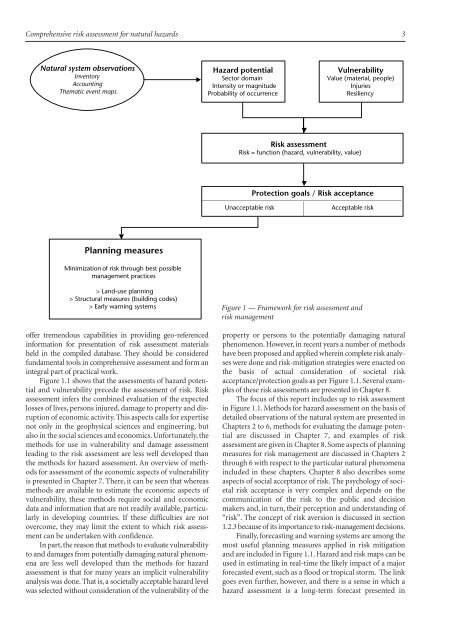Comprehensive Risk Assessment for Natural Hazards - Planat
Comprehensive Risk Assessment for Natural Hazards - Planat
Comprehensive Risk Assessment for Natural Hazards - Planat
You also want an ePaper? Increase the reach of your titles
YUMPU automatically turns print PDFs into web optimized ePapers that Google loves.
<strong>Comprehensive</strong> risk assessment <strong>for</strong> natural hazards<br />
3<br />
<strong>Natural</strong> system observations<br />
Inventory<br />
Accounting<br />
Thematic event maps<br />
Hazard potential<br />
Sector domain<br />
Intensity or magnitude<br />
Probability of occurrence<br />
Vulnerability<br />
Value (material, people)<br />
Injuries<br />
Resiliency<br />
<strong>Risk</strong> assessment<br />
<strong>Risk</strong> = function (hazard, vulnerability, value)<br />
Protection goals / <strong>Risk</strong> acceptance<br />
Unacceptable risk<br />
Acceptable risk<br />
Planning measures<br />
Minimization of risk through best possible<br />
management practices<br />
> Land-use planning<br />
> Structural measures (building codes)<br />
> Early warning systems<br />
offer tremendous capabilities in providing geo-referenced<br />
in<strong>for</strong>mation <strong>for</strong> presentation of risk assessment materials<br />
held in the compiled database. They should be considered<br />
fundamental tools in comprehensive assessment and <strong>for</strong>m an<br />
integral part of practical work.<br />
Figure 1.1 shows that the assessments of hazard potential<br />
and vulnerability precede the assessment of risk. <strong>Risk</strong><br />
assessment infers the combined evaluation of the expected<br />
losses of lives, persons injured, damage to property and disruption<br />
of economic activity. This aspects calls <strong>for</strong> expertise<br />
not only in the geophysical sciences and engineering, but<br />
also in the social sciences and economics. Un<strong>for</strong>tunately, the<br />
methods <strong>for</strong> use in vulnerability and damage assessment<br />
leading to the risk assessment are less well developed than<br />
the methods <strong>for</strong> hazard assessment. An overview of methods<br />
<strong>for</strong> assessment of the economic aspects of vulnerability<br />
is presented in Chapter 7. There, it can be seen that whereas<br />
methods are available to estimate the economic aspects of<br />
vulnerability, these methods require social and economic<br />
data and in<strong>for</strong>mation that are not readily available, particularly<br />
in developing countries. If these difficulties are not<br />
overcome, they may limit the extent to which risk assessment<br />
can be undertaken with confidence.<br />
In part, the reason that methods to evaluate vulnerability<br />
to and damages from potentially damaging natural phenomena<br />
are less well developed than the methods <strong>for</strong> hazard<br />
assessment is that <strong>for</strong> many years an implicit vulnerability<br />
analysis was done. That is, a societally acceptable hazard level<br />
was selected without consideration of the vulnerability of the<br />
Figure 1 — Framework <strong>for</strong> risk assessment and<br />
risk management<br />
property or persons to the potentially damaging natural<br />
phenomenon. However, in recent years a number of methods<br />
have been proposed and applied wherein complete risk analyses<br />
were done and risk-mitigation strategies were enacted on<br />
the basis of actual consideration of societal risk<br />
acceptance/protection goals as per Figure 1.1. Several examples<br />
of these risk assessments are presented in Chapter 8.<br />
The focus of this report includes up to risk assessment<br />
in Figure 1.1. Methods <strong>for</strong> hazard assessment on the basis of<br />
detailed observations of the natural system are presented in<br />
Chapters 2 to 6, methods <strong>for</strong> evaluating the damage potential<br />
are discussed in Chapter 7, and examples of risk<br />
assessment are given in Chapter 8. Some aspects of planning<br />
measures <strong>for</strong> risk management are discussed in Chapters 2<br />
through 6 with respect to the particular natural phenomena<br />
included in these chapters. Chapter 8 also describes some<br />
aspects of social acceptance of risk. The psychology of societal<br />
risk acceptance is very complex and depends on the<br />
communication of the risk to the public and decision<br />
makers and, in turn, their perception and understanding of<br />
“risk”. The concept of risk aversion is discussed in section<br />
1.2.3 because of its importance to risk-management decisions.<br />
Finally, <strong>for</strong>ecasting and warning systems are among the<br />
most useful planning measures applied in risk mitigation<br />
and are included in Figure 1.1. Hazard and risk maps can be<br />
used in estimating in real-time the likely impact of a major<br />
<strong>for</strong>ecasted event, such as a flood or tropical storm. The link<br />
goes even further, however, and there is a sense in which a<br />
hazard assessment is a long-term <strong>for</strong>ecast presented in

















